When venturing outdoors for photography, having the right accessories can make all the difference in capturing stunning images. Essential items such as tripods, lens filters, and external flashes not only enhance your shooting experience but also protect your gear from unpredictable weather conditions. By investing in these must-have tools, you ensure stability, improved lighting, and convenience, allowing you to focus on your creative vision.

What photography accessories are essential for outdoor shoots?
Essential photography accessories for outdoor shoots include tripods, lens filters, camera bags, external flashes, and remote shutter releases. These tools enhance stability, protect equipment, facilitate transport, improve lighting, and provide convenience, ensuring a successful outdoor photography experience.
Tripods for stability
Tripods are crucial for maintaining stability during outdoor shoots, especially in windy conditions or low-light situations. A sturdy tripod minimizes camera shake, allowing for sharper images and longer exposure times.
When selecting a tripod, consider its weight, height, and material. Lightweight aluminum or carbon fiber tripods are ideal for portability, while models with adjustable legs can adapt to uneven terrain.
Lens filters for protection
Lens filters serve dual purposes: they protect the lens from scratches and dirt while enhancing image quality. Common types include UV filters, polarizers, and neutral density filters, each offering unique benefits for outdoor photography.
For instance, a polarizing filter reduces glare from reflective surfaces like water or glass, while a neutral density filter allows for longer exposures in bright conditions. Always choose high-quality filters to avoid degrading image clarity.
Camera bags for transport
Camera bags are essential for safely transporting your gear during outdoor shoots. A well-designed bag protects your equipment from environmental elements and provides easy access to your camera and accessories.
Look for bags with padded compartments, weather-resistant materials, and adjustable straps. Backpack-style bags are particularly useful for hiking, as they distribute weight evenly and keep your hands free.
External flashes for lighting
External flashes enhance lighting in outdoor photography, especially in harsh sunlight or shaded areas. They provide additional light to fill shadows and improve subject illumination.
When using an external flash, consider its power output and versatility. Models with adjustable settings allow you to control the intensity and direction of light, enabling creative effects and balanced exposures.
Remote shutter releases for convenience
Remote shutter releases offer convenience by allowing you to take photos without physically touching the camera. This reduces the risk of camera shake and is particularly useful for long exposures or self-portraits.
Choose between wired and wireless options based on your needs. Wireless remotes provide greater flexibility, while wired versions are often more reliable in challenging conditions. Always test your remote before heading out to ensure compatibility with your camera model.
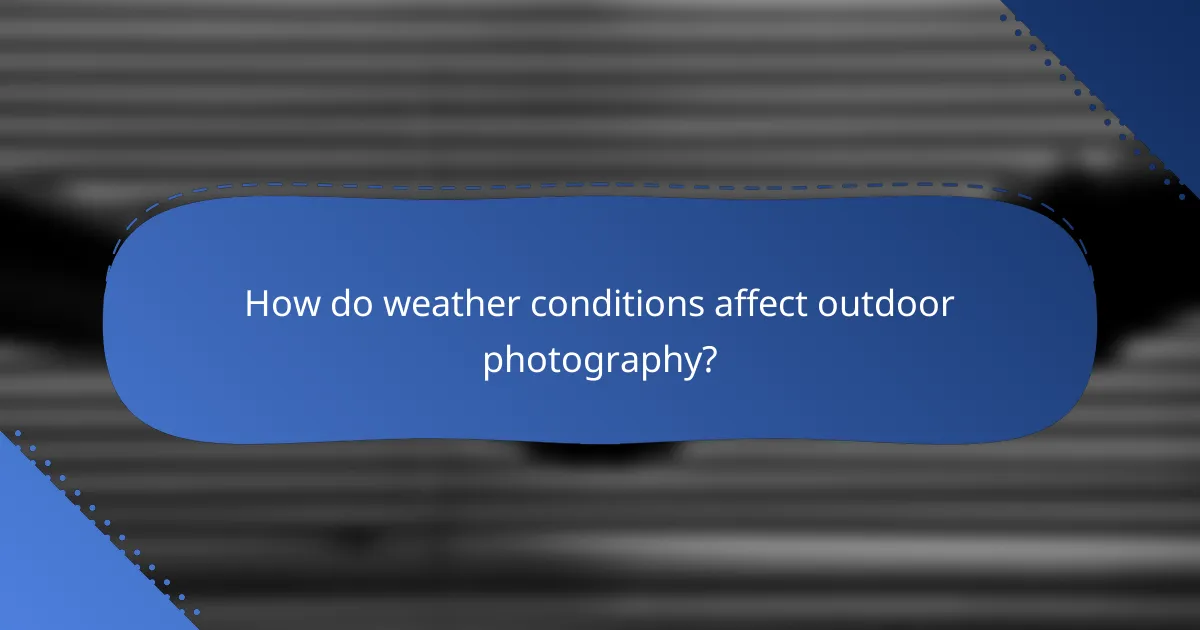
How do weather conditions affect outdoor photography?
Weather conditions can significantly impact outdoor photography by influencing lighting, visibility, and equipment safety. Factors such as rain, wind, and temperature changes can affect both the quality of images and the durability of your gear.
Rain covers for protection
Rain covers are essential for protecting your camera and lenses from moisture during outdoor shoots. They come in various forms, including fitted covers and universal sleeves, allowing you to choose based on your equipment and shooting style.
When selecting a rain cover, consider its material and waterproof rating. Look for covers that are lightweight yet durable, ensuring they can withstand heavy rain without compromising accessibility to your camera controls. A good fit is crucial to prevent water from seeping in.
Lens hoods to reduce glare
Lens hoods are designed to block stray light from entering the lens, which helps reduce glare and improve contrast in your images. They are particularly useful in bright outdoor conditions, such as sunny days or when shooting near reflective surfaces.
When choosing a lens hood, ensure it is compatible with your lens size and type. A properly fitted hood will not only enhance image quality but also provide some protection against accidental bumps and scratches. Remember to remove the hood when shooting in low-light conditions to avoid vignetting.
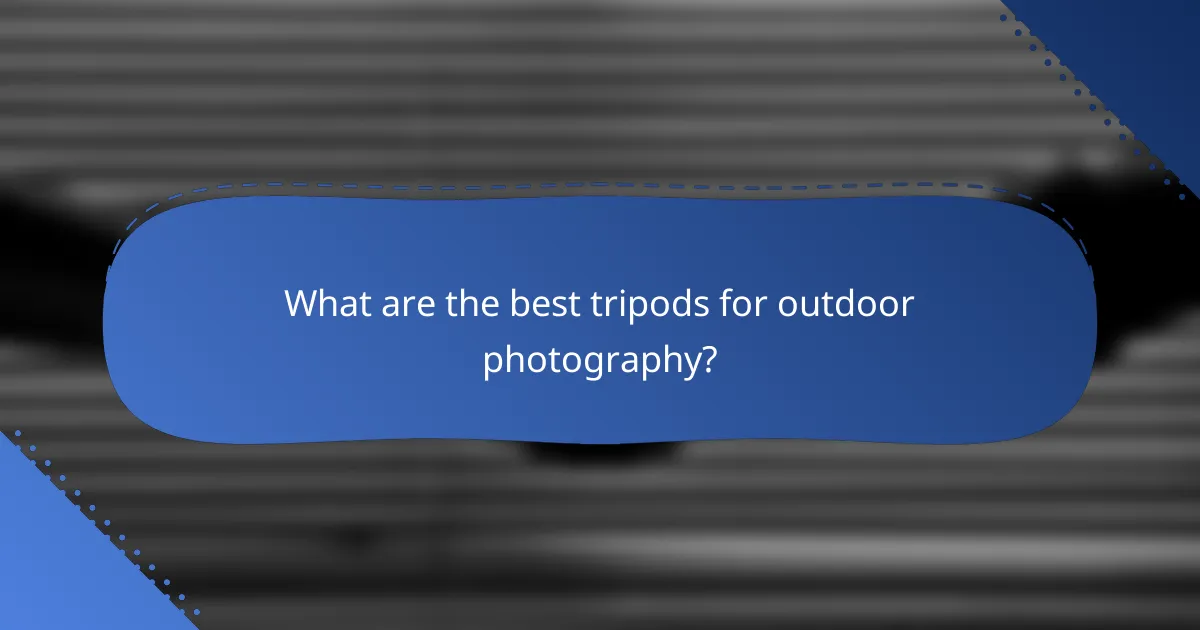
What are the best tripods for outdoor photography?
The best tripods for outdoor photography are lightweight, durable, and versatile, allowing photographers to capture stable images in various conditions. Key factors to consider include weight capacity, height adjustability, and ease of setup.
Manfrotto Befree Advanced
The Manfrotto Befree Advanced is a compact and lightweight tripod designed specifically for travel photographers. Weighing around 1.5 kg, it can support up to 8 kg, making it suitable for most DSLR and mirrorless cameras with lenses.
This tripod features a quick-release plate for fast setup and a ball head for smooth adjustments. Its aluminum construction provides durability without adding excessive weight, making it an excellent choice for outdoor shoots.
Gitzo Traveler Series
The Gitzo Traveler Series tripods are known for their exceptional stability and lightweight design, ideal for outdoor photography. These tripods typically weigh between 1.2 kg and 1.5 kg and can support loads of up to 10 kg, accommodating heavier camera setups.
Constructed from high-quality carbon fiber, the Gitzo Traveler tripods offer excellent vibration dampening and are resistant to the elements. Their compact folding design makes them easy to carry, ensuring you can take them on any adventure.
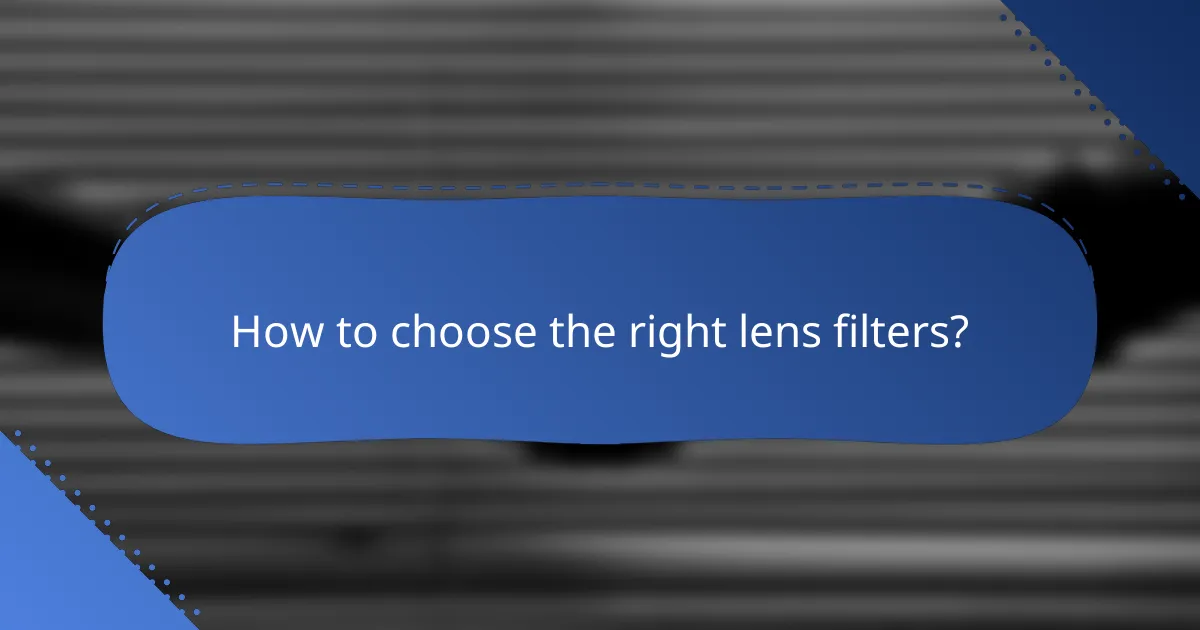
How to choose the right lens filters?
Choosing the right lens filters involves understanding their specific functions and how they can enhance your outdoor photography. Consider the type of shooting conditions you will encounter and select filters that best address those needs.
UV filters for lens protection
UV filters primarily serve to protect your lens from scratches, dust, and moisture. While digital cameras often have built-in UV filtering, using a UV filter can still provide an additional layer of defense for your lens during outdoor shoots.
When selecting a UV filter, look for high-quality options that do not degrade image quality. A good rule of thumb is to choose filters with multi-coating to minimize reflections and maintain clarity.
Polarizing filters for glare reduction
Polarizing filters are essential for reducing glare from reflective surfaces like water and glass, enhancing color saturation and contrast in your images. They work by filtering out polarized light, allowing for clearer and more vibrant photographs.
To use a polarizing filter effectively, rotate it while looking through the viewfinder to find the optimal angle that reduces glare. Keep in mind that these filters can reduce the amount of light entering the lens, so you may need to adjust your exposure settings accordingly.
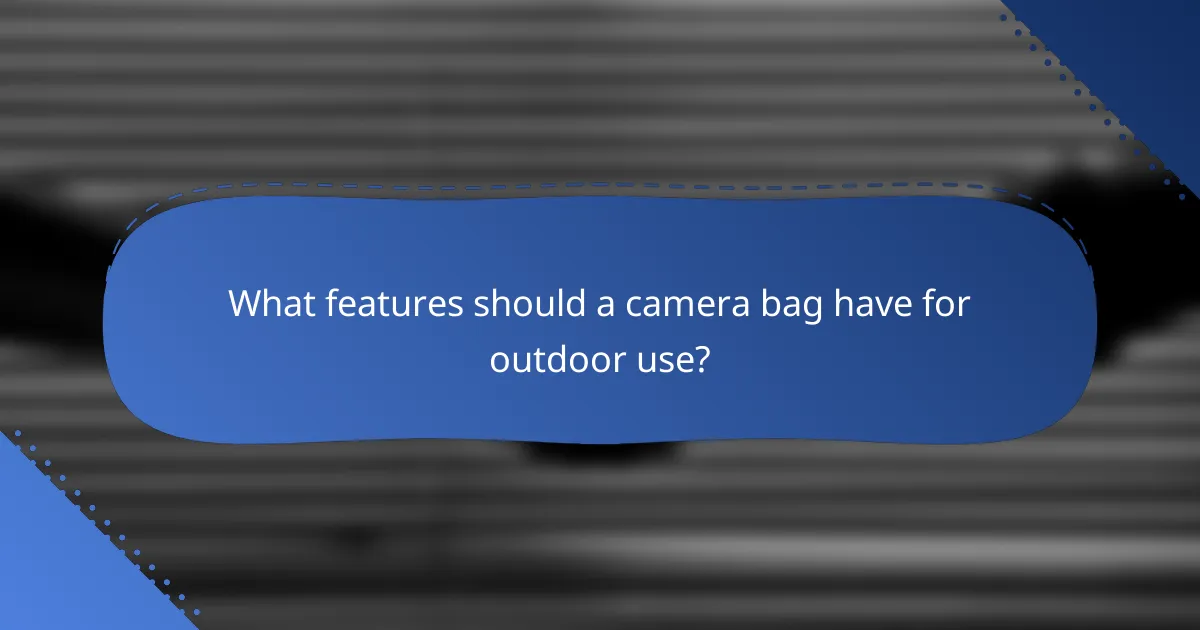
What features should a camera bag have for outdoor use?
A camera bag for outdoor use should be durable, weather-resistant, and designed to protect your gear from the elements. Key features include water-resistant materials and padded compartments to ensure your equipment remains safe during shoots in various conditions.
Water-resistant material
Choosing a camera bag made from water-resistant material is crucial for outdoor photography. Look for fabrics like nylon or polyester with a waterproof coating to keep moisture at bay. This feature helps protect your camera and lenses from unexpected rain or splashes.
Additionally, consider bags with sealed zippers and water-resistant flaps to further enhance protection. A bag that can withstand light rain or splashes will give you peace of mind while shooting in unpredictable weather.
Padded compartments for gear
Padded compartments are essential for safeguarding your camera and accessories during outdoor shoots. These compartments should be adjustable to accommodate different gear sizes and configurations, allowing you to customize the layout based on your needs.
When selecting a bag, ensure the padding is thick enough to absorb shocks from bumps or drops. This will help prevent damage to your equipment, especially when navigating rough terrain or during transport.
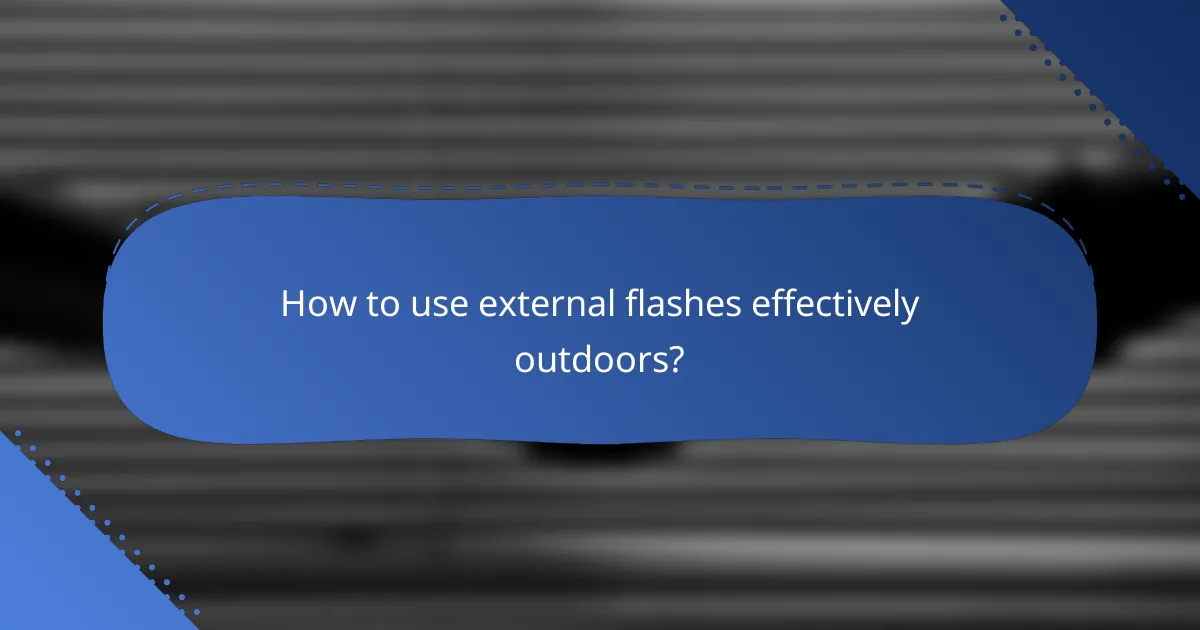
How to use external flashes effectively outdoors?
To use external flashes effectively outdoors, adjust the flash settings to complement natural light and enhance your subject. Understanding how to balance flash power with ambient light is crucial for achieving well-exposed images.
Adjusting flash power for ambient light
When shooting outdoors, the intensity of ambient light can vary significantly based on the time of day and weather conditions. Start by assessing the natural light; during bright daylight, you may need to set your flash to a lower power to avoid overexposure, while in shaded areas, a higher power might be necessary.
A good rule of thumb is to begin with flash power set to around 1/4 to 1/2 of its maximum output and adjust from there based on the results. Experimenting with different power levels will help you find the right balance for your specific shooting conditions.
Using diffusers for softer light
Diffusers are essential for softening the harsh light produced by external flashes, especially in outdoor settings. By placing a diffuser in front of your flash, you can create a more flattering light that reduces shadows and highlights on your subject’s face.
Common options for diffusers include softboxes, umbrellas, or even simple materials like white bedsheets. When using a diffuser, remember to increase the flash power slightly, as the diffusion process will absorb some light, ensuring your subject remains well-lit.
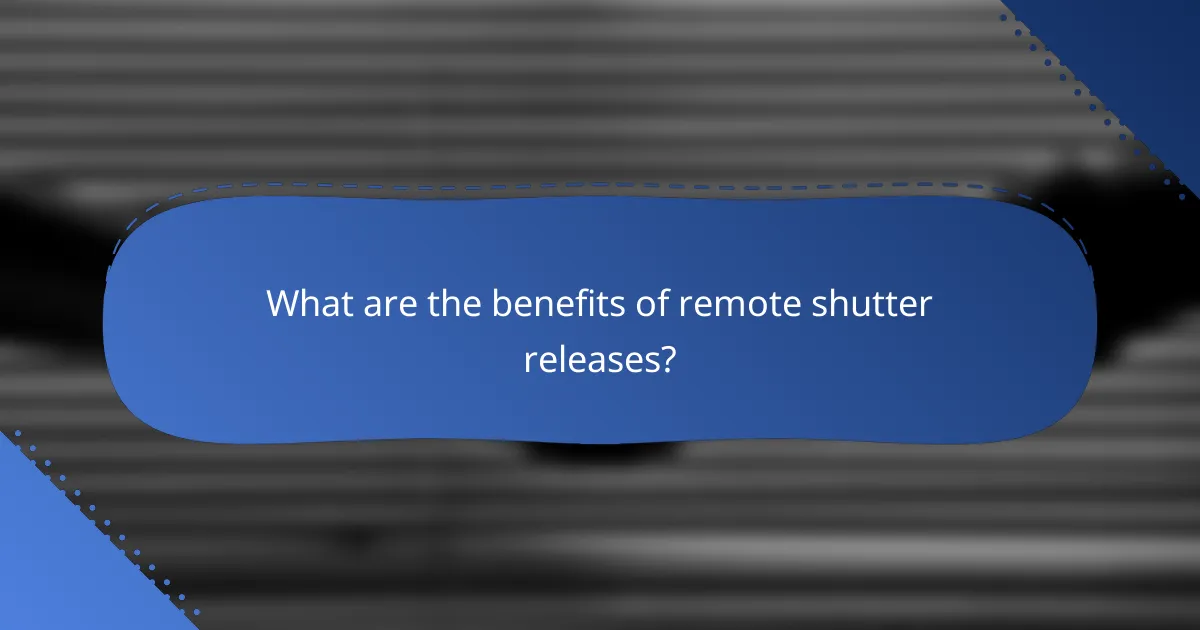
What are the benefits of remote shutter releases?
Remote shutter releases offer photographers greater control over their shots, allowing them to capture images without physically touching the camera. This reduces camera shake and enables more precise timing, especially in challenging shooting conditions.
Improved Stability
Using a remote shutter release enhances stability during photography, particularly in long exposure or macro shots. By eliminating the need to press the shutter button directly, you minimize vibrations that can blur images. This is especially beneficial when shooting on tripods or in low-light situations.
Better Timing
Remote shutter releases allow for better timing when capturing fleeting moments, such as wildlife or sports events. With options like intervalometers, photographers can set specific intervals for continuous shooting, ensuring they don’t miss critical action. This feature is invaluable for capturing dynamic scenes.
Versatile Shooting Options
Remote shutter releases provide versatility in shooting angles and compositions. Photographers can position their cameras in hard-to-reach spots and trigger the shutter from a distance. This is particularly useful for self-portraits or group photos where the photographer wants to be included without running back to the camera.
Wireless Convenience
Many modern remote shutter releases are wireless, offering the convenience of triggering the camera from several meters away. This feature is ideal for outdoor shoots where the photographer may need to maintain a distance from the subject, such as in wildlife photography. Wireless options often come with additional features like smartphone connectivity for added control.
